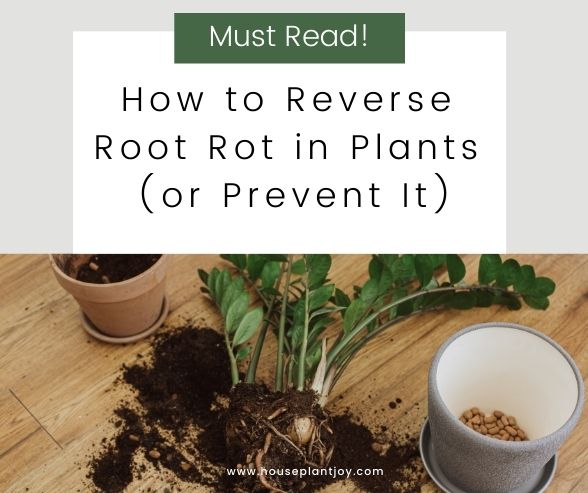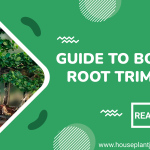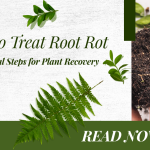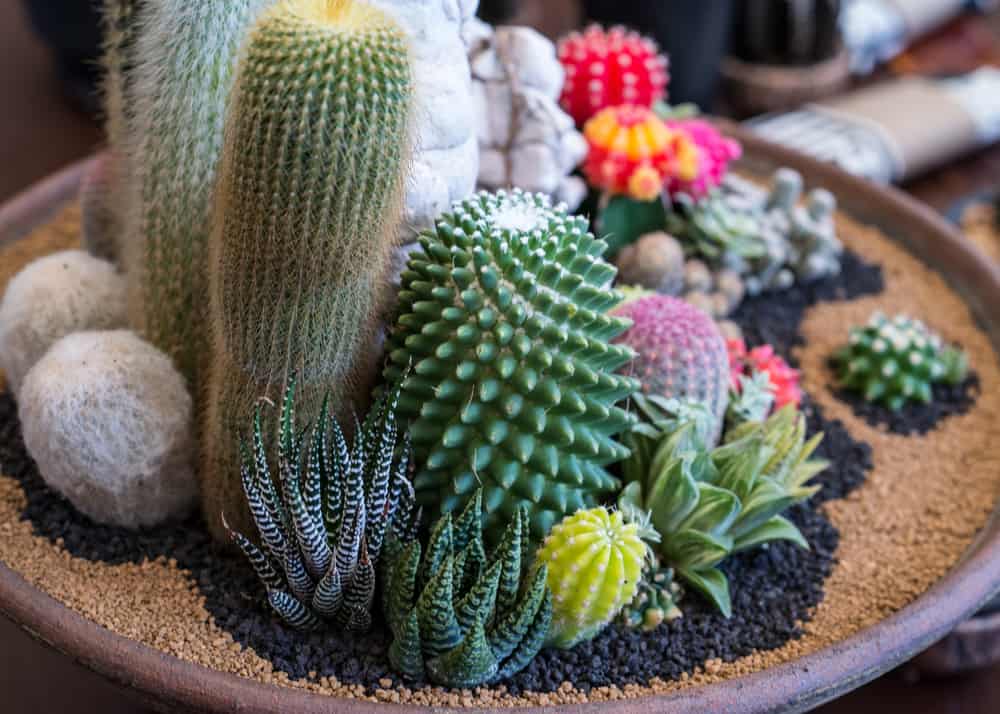HousePlantJoy is supported by our audience. When you purchase through one of our links, we may earn a small affiliate commission. As an Amazon Associate I earn from qualifying purchases. Your cost is not affected.
==================
Your beloved plant seems sick. You look for the problem. Why are the leaves turning a yellow color? In fact, the stems struggle to survive, too. You finally check the roots. Oh no! It’s root rot! But, do you know how to reverse root rot in plants? It is possible if the plant still shows some life.
If you overwater a plant, it may not appear to recover as quickly as it should. The leaves become drab and yellow, and the entire plant seems to be on a downward spiral toward death.
We make several attempts to solve the irrigation problem, but nothing appears to work. Root rot is most likely the cause of our plant’s development issues.
What Is Root Rot?
Root rot has two causes. One is continuous overwatering, which can cause root rot due to a lack of oxygen. They can rot or deteriorate as they die. Even if the soil conditions improve, the rot might spread to healthy roots and kill them. Another source is soil fungus. Fungi can grow on the plant if you water them twice. The root rot fungus targets the roots, killing and rotting them.
Root rot is a disease that can lead to the death of plants if the condition remains untreated. The first signs of root rot develop beneath the soil’s surface. With that, gardeners become unaware of the problem until it is obvious. You should address rotting roots symptoms such as yellow leaves or slow growth as soon you see it on the plant.
Root rot is widespread in deep soils or containers with inadequate drainage holes. Root rot can affect garden plants as well as container plants. Preventing garden root rot is as simple as improving soil drainage before planting. While too much amount of water can cause root rot, the underlying culprit is a fungus.
Root Rot Causes
Two factors cause root rots. Overwatering the spill is the most common of them all. If you overwater the roots, they will be unable to absorb the oxygen they require to survive. The deterioration of the dry roots can cause rot to spread to other healthy roots.
Another factor that causes root rot is soil fungus. Fungus weakens roots. In damp soil, the fungal spores can come to life and attack the bases, causing them to rot and die. Pythium, Phytophthora, Rhizoctonia, and fusarium are more well-known fungi that cause root rot. Armillaria, often known as shoestring rot, also damages hardwoods and conifers.
What Are the Characteristics of Root Rot?
What does root rot look like? If we are not sure if our plant has root rot, we might be thinking, “what does root rot look like?”
Identifying and inspecting the roots will be necessary if the plant is withering. Another thing to watch out for is if the leaves turn yellow for an unknown reason.
To check, take the plant out of the soil and feel the roots with your fingers. Root rot may appear dark and feel mushy. When we touch the roots of an affected plant, they may fall off. Healthy roots may appear black or pale, but they will be firm and malleable to the touch. Soft, brown roots indicate root rot. Now, you need to know how to reverse root rot in plants. Yes, it is quite possible, assuming the plant contains some life.
Healthy roots are solid and white. This is because toxic fungi develop and spread in damp soil, commencing at the roots’ extremities. In contrast, succulent root parts become black and mushy. Again, this is because of the plant’s inability to absorb nutrients.
Plant growth slows down as leaves wilt, yellow, or fall off. Plants can die in 10 days if the fungus spreads quickly. If a plant develops these symptoms, loosen the soil around the root and dig it out. Shake the ground and look for rot.
Symptoms and Diagnosis of Root Rot
Many root rot symptoms are the same as those of a pest infestation. It becomes more difficult to distinguish between the two. The signs of root rot are much more visible above ground, which makes it easier to diagnose.
These are some root rot symptoms and diagnoses:
- There is no evident reason for the gradual or rapid decline.
- Poor plant growth.
- Leaves are tiny and pale.
- Leaves become wilted, yellow, or brown.
- Branch dieback is a problem.
- The canopy is getting thinner.
- The fungus creeps up from the roots to the inner bark and forms cankers. These become the dead regions that have sunken into the ground.
To accurately diagnose root rot, you must dig beneath the surface to see if decomposing is going place. A pulaski is an excellent tool for this since it is two-sided. One side is for cutting, and the other is for digging or scraping; this makes it versatile. However, we need to give it a big deal of caution exercise when doing this procedure to avoid causing more damage to the tree.
Managing Root Rot
When we diagnose a root rot, treating root rot is necessary to decide whether to rescue the plant. Unless the entire root system has already gone mushy, it seems too late to save the root from extinction. If not, on the other hand, there are some healthy, white, solid roots present. However, you may attempt to save the plant by replanting it on new soil.
Ensure that the roots of the plants are clean and free of brown, mushy roots. You may do so by cutting them off with a sharp pair of scissors and wiping the sources gently under running water. Next, cut the plant’s healthy root above its damaged area. Work swiftly to ensure that we will replant plants within a few hours.
After you have pruned the roots, sanitize the scissors. Use a solution of one part bleach and three parts water. Sanitizing will prevent the transmission of fungi to other plants or the soil.
Root rot is one of the major concerns for gardeners. They were fixing it as soon as symptoms appear increases the chance of saving the plants. First, make sure that the soil is not too wet. To do so, provide adequate drainage and a healthy soil condition for our plants to thrive in.
Prevention Offers the Best Solution
Preventing root rot is a straightforward process. It all comes down to watering and drainage. We will never notice root rot in our plants if we follow these basic guidelines.
-
Make Sure Our Plant Has Adequate Drainage
Ensure that we potted our plant into something that has drainage holes. Such as a plastic nursery pot or decorative pot with a drainage hole in the bottom of the pot. Suppose our decorative pot does not include a drainage hole. In that case, we can leave the plant in its plastic pot. You may set it inside the decorative pot to prevent it from becoming waterlogged.
-
Maintain a Consistent Watering Routine
Watering plants regularly is a must. However, watering our plant on an infrequent basis can damage it. Too much water can result in the plant not having enough time to dry out between watering periods.
-
Examine the Soil
Always check the soil of our plant before watering it, if we haven’t done already. Most plants prefer to have a little space to breathe, depending on the type of plant we have. We may want to wait until the top two inches of soil are completely dry before watering.
-
Aerate the Soil to Improve Its Drainage
It is possible to loosen the soil by aerating it. It allows a more even distribution of water and greater oxygen flow. In addition, it will prevent moisture from building up in the roots of your plant.
How to Reverse Root Rot
Whether the problem results from repeated or single overwatering, you should take action. We should treat root rot as soon as possible to give our plant the best chance of survival.
The roots of plants must keep in good condition to correct and avoid root rot. In addition, we must prevent overwatering, allow drainage, replace the soil, and choose healthy plants.
-
Do Not Overwater
How to reverse root rot in plants? Or even prevent it from starting? The solution to reversing root rot might surprise you. In fact, it seems quite simple.
Following a regular watering regimen that matches the plant’s water requirements is essential. In addition, gardeners should focus on soil saturation and temperatures before starting their projects.
-
Ensure Provisions for Proper Soil Drainage
The soil around the plants cannot be too heavy or unable to retain water. You should use potting soil for container plants, ensuring that the pots should have drainage holes. Empty any saucers beneath houseplants should regularly to maintain fresh soil. Pot the plants in containers that are adequate in size. Do not use enormous jackpots to avoid excess moisture in the soil.
-
Replace the Old Soil
Whenever possible, replace an old plant with a new plant in the exact location of your garden. This will prevent the soil from becoming contaminated.
-
Choose a Healthy Plant System
Gardeners should inspect plants at the garden center to ensure good roots. Always check the core should be delicately slipped out of the grow pot. The soil should not have a bad smell, and the origins of a healthy plant will be green or white.
Takeaway
Before you toss out that failing plant, learn how to reverse root rot. In fact, concentrate on preventing this disease before it begins. In the fight against root rot, the most vital weapon is persistent observation. Yet, even specialists confess that many of their failures were due to a lack of attention.
Establish a routine of closely monitoring our plants and taking appropriate action. Look for any changes in their growth or color that are not normal. Please keep track of how quickly the topsoil dries out. You must also become accustomed to their watering schedule. Finally, keep an eye out for symptoms of dormancy.
Plants do not speak intelligibly, but they do communicate. Therefore, learning the language of the green thumb is essential to become one. By paying attention, we can always prevent the misery, the shame, and the stinky mess that comes with root rot.
FAQs
Can plants with remaining healthy roots recover from root rot?
Yes, if a plant has some healthy roots remaining, there is a chance for recovery. Trimming off the infected roots and providing proper care, such as adjusting watering practices and improving soil drainage, can support the regrowth of healthy roots and help the plant overcome root rot.
What should I do if the root rot has affected my plants?
If you suspect root rot in your plants, it’s important to take immediate action. Start by carefully inspecting the roots and identifying the extent of the damage. Trim off the infected roots, apply appropriate treatments, such as fungicides or natural remedies, and adjust watering practices to prevent further damage.
How can I prevent root rot in affected plants?
To prevent root rot in affected plants, it’s crucial to address the underlying causes. Ensure proper drainage by using well-draining soil and pots with drainage holes. Avoid overwatering and allow the soil to dry out between waterings. Additionally, practicing good hygiene, such as disinfecting tools and avoiding cross-contamination, can help prevent the spread of root rot pathogens.








